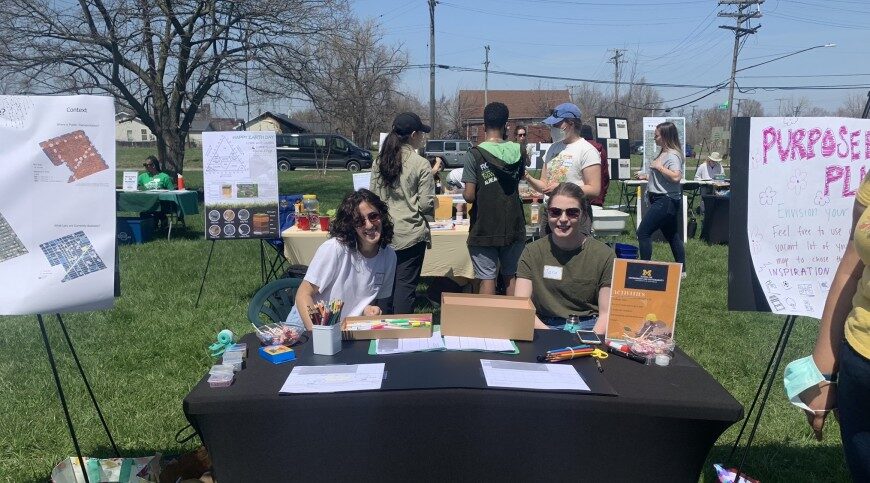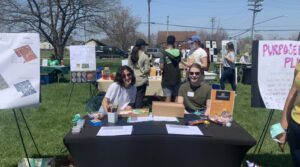Source: School of Environment and Sustainability

Knowing that the EAS-677: Engagement for Impact course would succeed “if we introduced students to real projects, real partners, real issues,” said Lisa DuRussel, assistant professor of practice of landscape architecture at U-M School for Environment and Sustainability.

Knowing that the EAS-677: Engagement for Impact course would succeed “if we introduced students to real projects, real partners, real issues,” said Lisa DuRussel, assistant professor of practice of landscape architecture at U-M School for Environment and Sustainability.
More Info
When Lisa DuRussell, Assistant Professor of Practice in Landscape Architecture at the School for Environment and Sustainability (SEAS), was asked to create a graduate-level, community-engaged course utilizing her professional background in 2021, she turned to the Ginsberg Center for assistance in getting connected with community partners.
Knowing that the EAS-677: Engagement for Impact course would succeed “if we introduced students to real projects, real partners, real issues,” DuRussell, who served as mentor fellow for the U-M Public Engagement Faculty Fellowship in the summer of 2021, reached out to Ginsberg Center Director Neeraja Aravamudan for guidance on finding the perfect fit.
“(Neeraja) mentioned Ginsberg’s ‘matchmaking’ process – I was immediately intrigued,” says DuRussell. “As a newer faculty member, I was interested in finding partnerships with community groups who were interested in working with the University on themes of ecology, design and engagement.”
From there, DuRussell connected with UniversityCommunity Partnerships Manager Amanda Healy – who, as she puts it, “made the magic happen,” helping to connect her course with the Bailey Park Neighborhood Development Corporation, a Detroit nonprofit serving the McDougall-Hunt neighborhood of the city by building and maintaining a new 22-acre park, among other initiatives.
“For a lot of neighborhood/community development organizations, development really means real estate and business, but that’s not all that we focus on,” says Bailey Park’s Director of Programs Amanda Paige. “We want to make sure that the existing residents who have roots in this neighborhood are not crowded out in the name of revitalization. The people who have weathered the disinvestment in McDougall-Hunt deserve to benefit from the reinvestment in the area. Our work makes sure they have every opportunity to have a voice in what that reinvestment looks like.”
An interdisciplinary team of 20 master’s students from SEAS, as well as the Ross School of Business, Taubman College of Architecture and Urban Planning and the School of Social Work, worked throughout the semester alongside Paige and others at Bailey Park to advance sustainability knowledge through various community engaged projects.
These projects centered around soil sampling and identification, purposeful neighborhood planning and understanding green infrastructure. These semester-long collaborations culminated in an Earth Day celebration at Bailey Park, where students and community members came together to share what they had learned.
Amanda Paige notes that a topdown approach is often present when institutions like the University of Michigan seek to collaborate with community partners, which can create frustration and miscommunication. “The students we worked with navigated that so well,” Paige says, recalling how students “met people where they were” and engaged in ways that were respectful and relatable.
The EAS-677 curriculum included work on equitable engagement and power dynamics, led by Roger B. Fisher of U-M Intergroup Relations, which helped students develop “a deeper understanding of the identities and membership groups of which they are a part of – and how power or stereotypes may accompany those identities,” says DuRussell.
Additionally, she notes that Ginsberg’s principles of engagement – including recognition, respect and equitable partnership – served as a “beacon” for each class session. In the future, Paige says that the organization hopes to collaborate more with DuRussell on more citizen science and direct impact work, as well as broadening the community’s exposure to SEAS.
DuRussell notes that EAS-677 students took away valuable knowledge: namely, a greater understanding “that community members are advocates and experts of their own space and lives.” She encourages other professors looking to teach a community-engaged course that it’s worth it, in spite of the planning and preparation they require: “Community-engaged courses have filled my own teaching pedagogy with greater purpose and meaning.”

